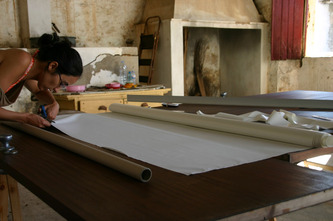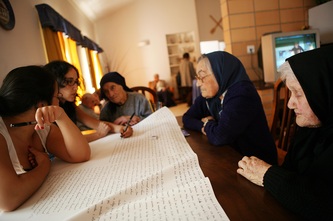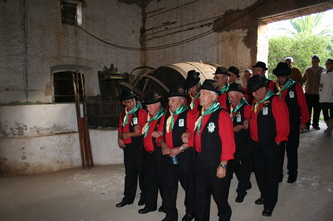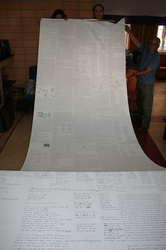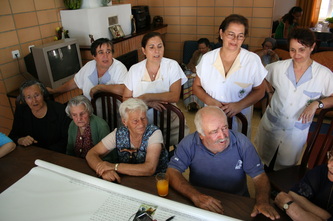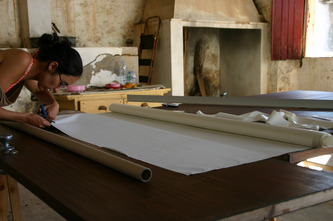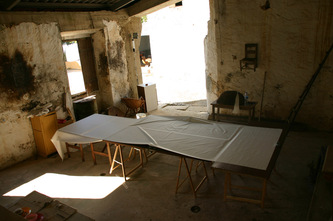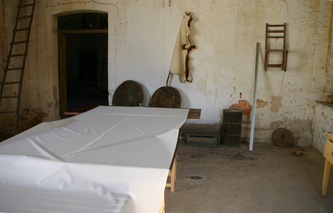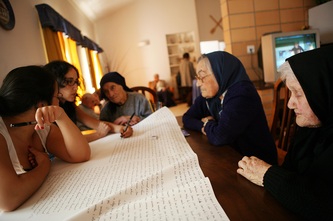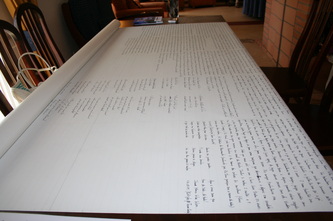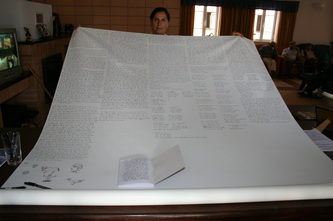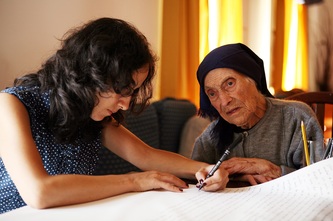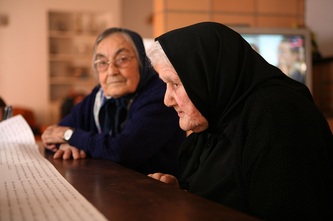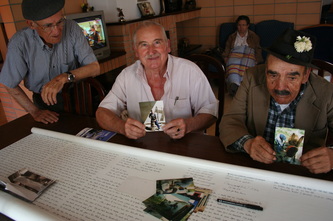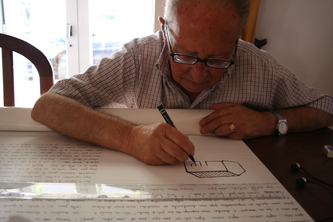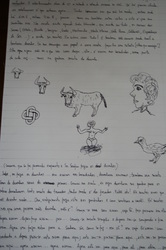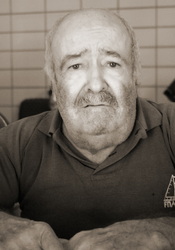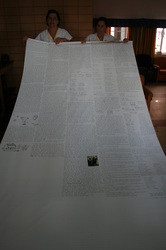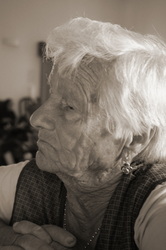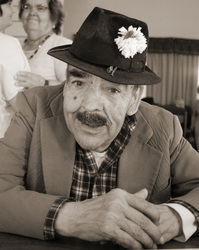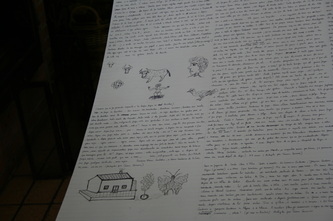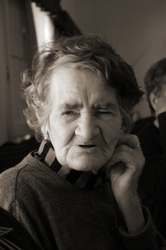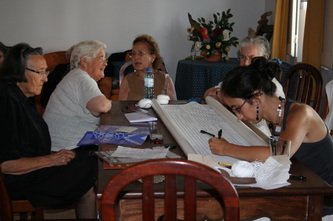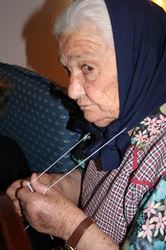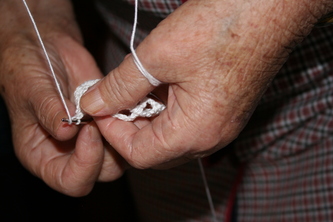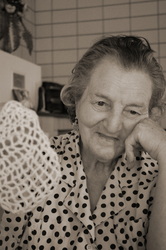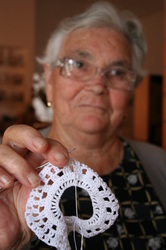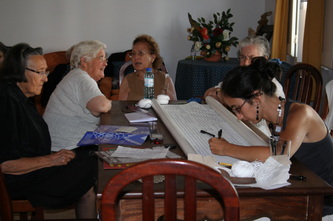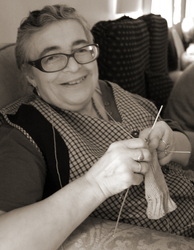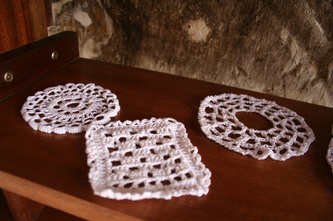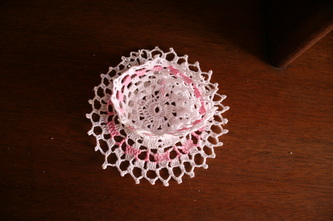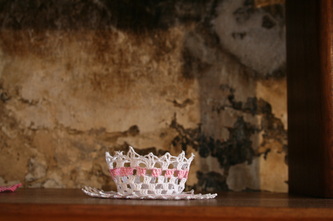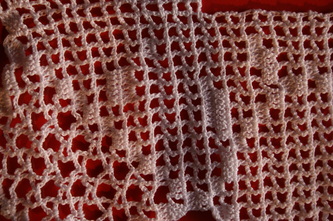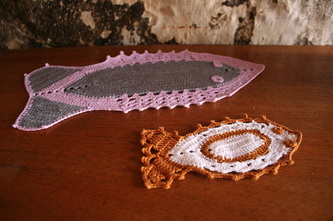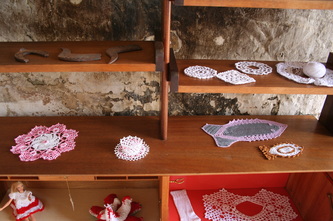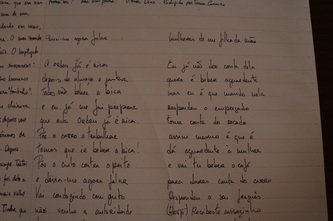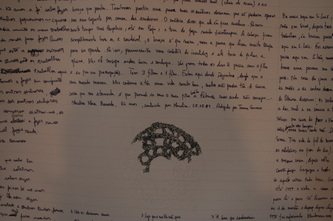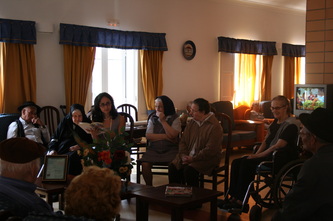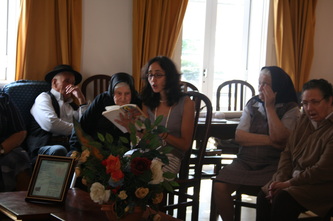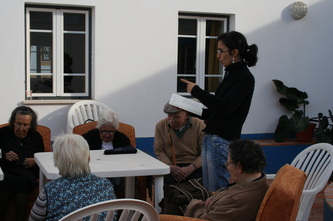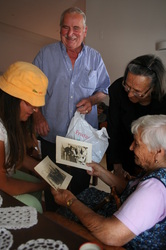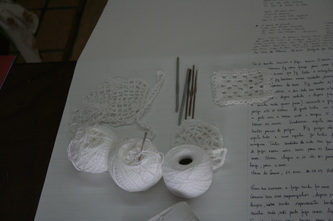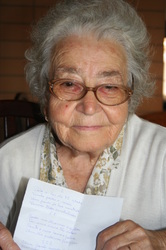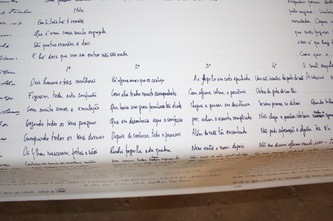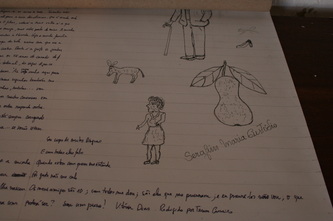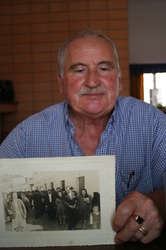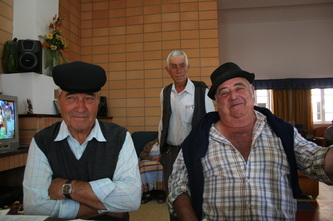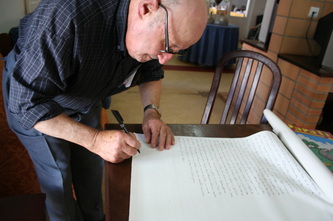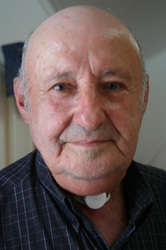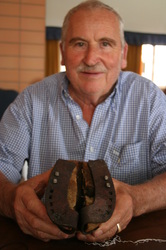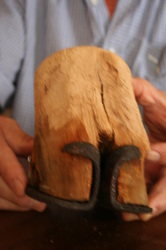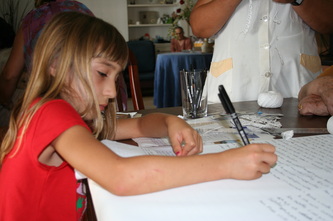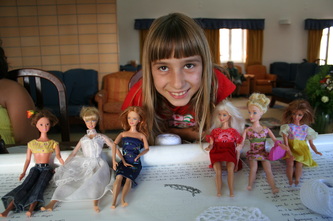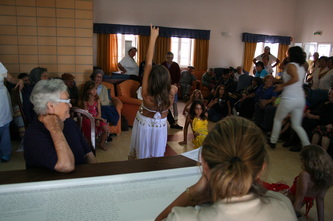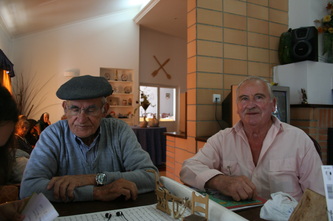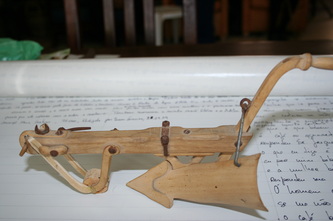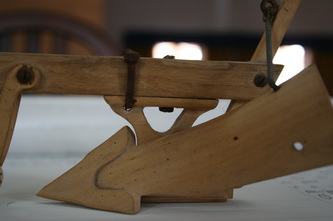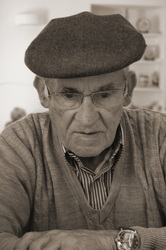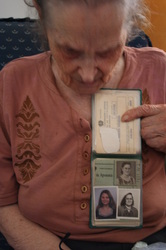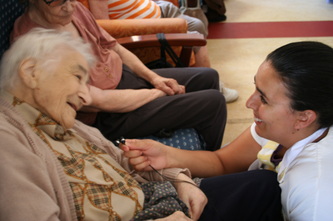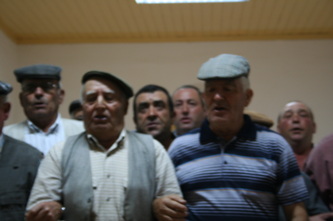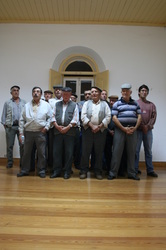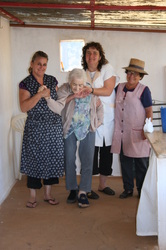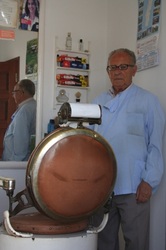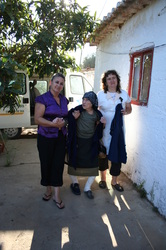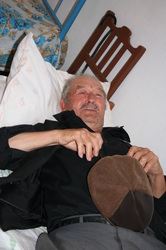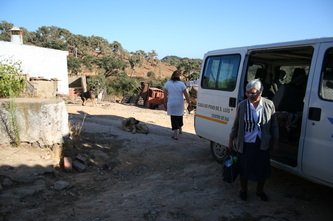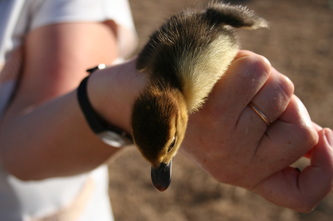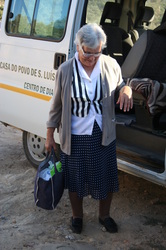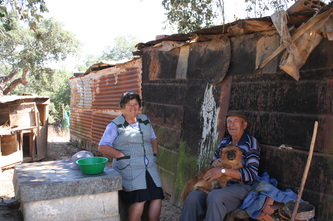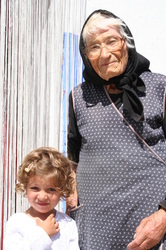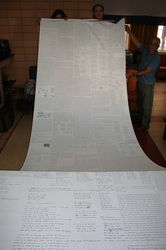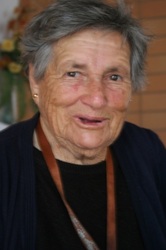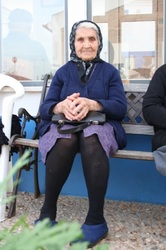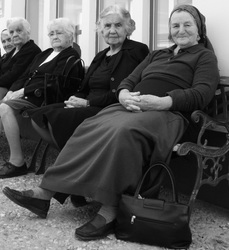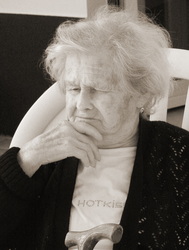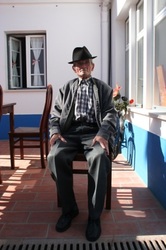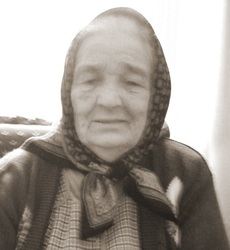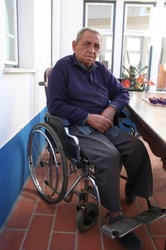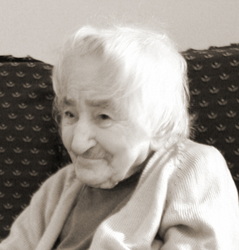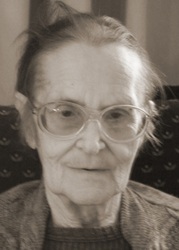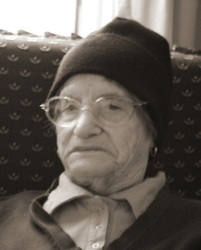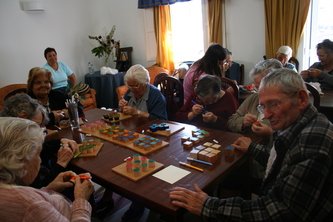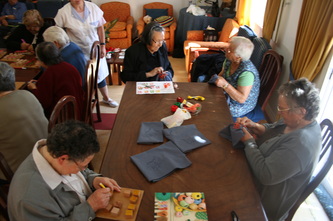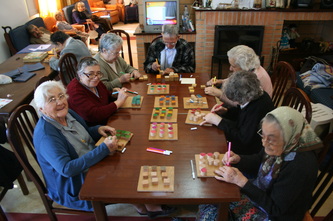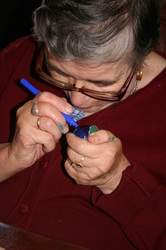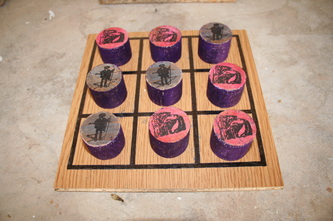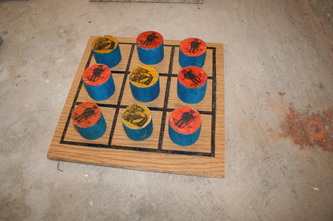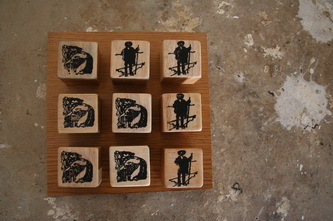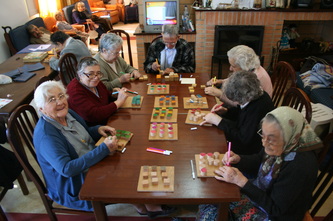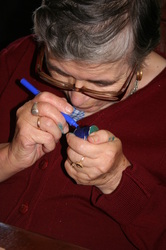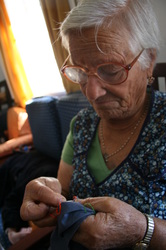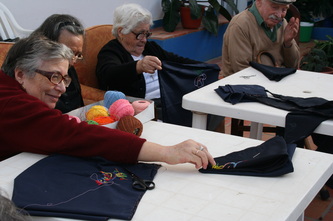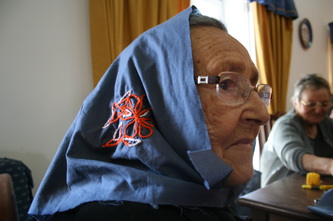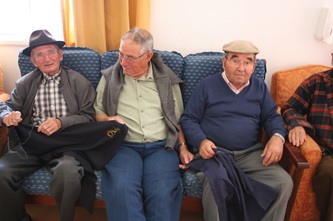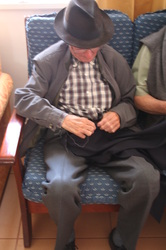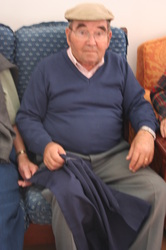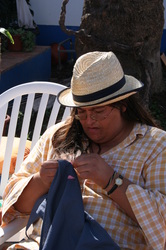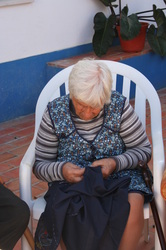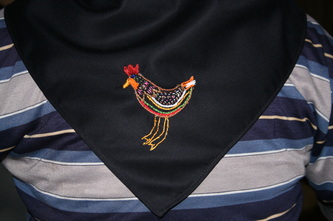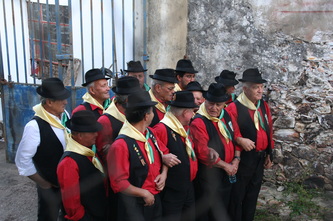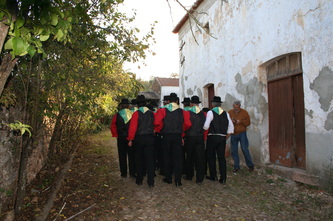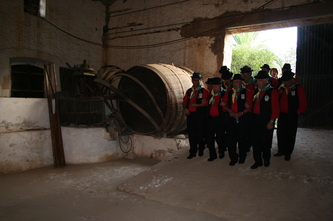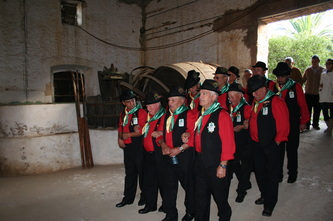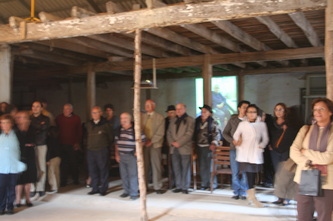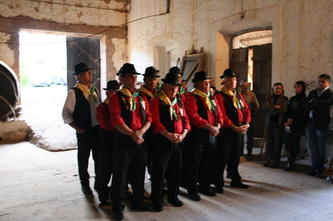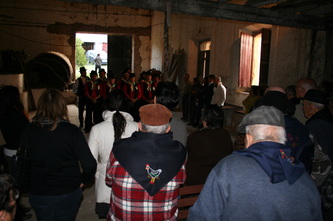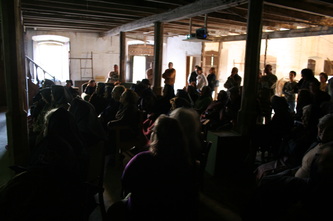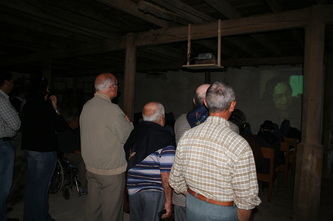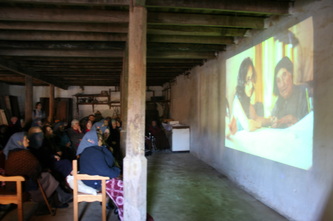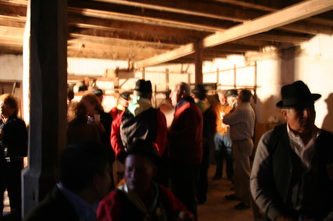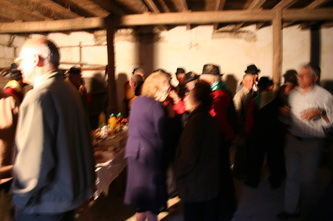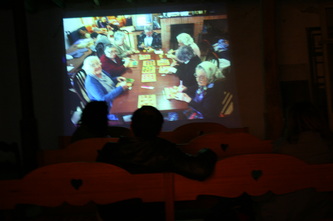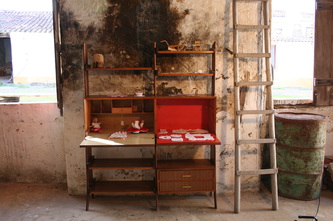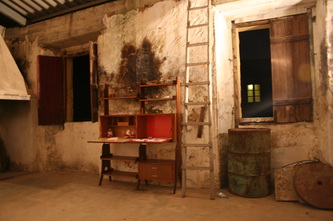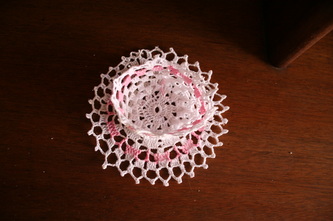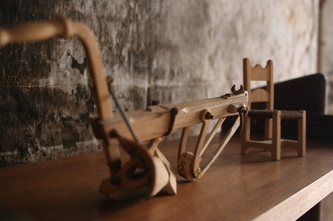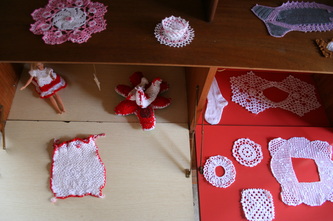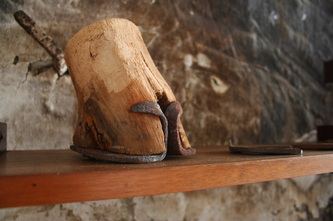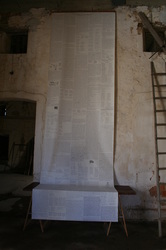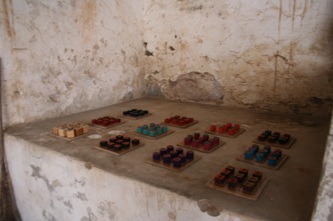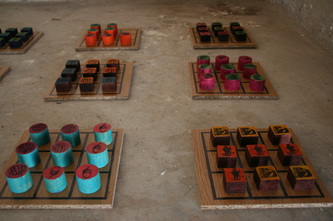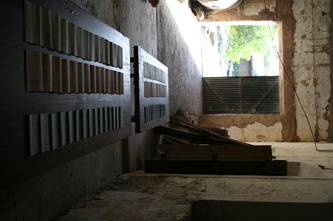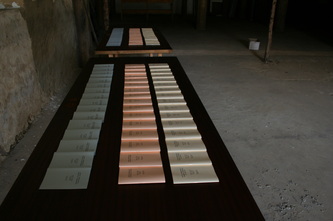_© All rigths reserved to Associação Espaços do
Desenho-Drawing Spaces. Text.Sound.Video.Images
_ COMMUNITARY
WEAVING I
Series of Activities and Workshops
S. LUÍS, ALENTEJO, PORTUGAL
Day Care Center from S. Luís, Alentejo, Portugal
Developed in partnership with ‘Cultivamos Cultura-Associação Cultural’
and DrawingSpaces
AUGUST 2009 – NOVEMBER 2009
Series of Activities and Workshops
S. LUÍS, ALENTEJO, PORTUGAL
Day Care Center from S. Luís, Alentejo, Portugal
Developed in partnership with ‘Cultivamos Cultura-Associação Cultural’
and DrawingSpaces
AUGUST 2009 – NOVEMBER 2009
REPORT 1 - IDEAL
Intercultural Drawing for European Adult Learning
WHAT
An extensive drawing residency hosted by ‘Cultivamos Cultura – Associação Cultural’, based in S. Luís, Alentejo (south of Portugal), with the participation of a group of elder people from the Day Care Center of the small village of S. Luís, Alentejo, as well as people from the village.
WHERE
Day Care Centre at the village of S. Luís, Alentejo, Portugal
WHEN
August 2009 – November 2009
WHO
Facilitators and Staff
Coordinator of the project/Staff – Teresa Carneiro
Facilitators – Inês Teles, Daniela Vasco, Sandra, Manuela Correia, Marta Carneiro
Adult Learners
About 400 people, 260 women and 140 men, from the Day Care Centreand from the village of S. Luís, Alentejo
WHY - CONTEXT
Communitary Weaving was a residency program supported by ‘Cultivamos Cultura – Associação Cultural’, under the responsibility of Teresa Carneiro, developed in partnership with ‘Drawing Spaces’. It took place at the Day Care Centre of the village of Saint Luis in the South of Portugal. This project set in place a number of drawing related activities, some of which developed over an extensive period of time, which seek to question, promote, open up, analyze and, to an extent, reconfigure, the roles and places of the members of a given community (in this case, the community of S. Luis), and therefore, the parameters for the constitution of the identity of such community. From the point of view of the Day Care Centre, one could ask for example, who are the direct participants of this community – the adults in need of ‘care’ who attended the Institution, staff members, family and friends who visited? Are there direct and indirect members of a community? Who/ what determines then the membership (who takes part in) of a community? On the other hand, located at the centre of the village of S. Luis, this Day Care Centre ‘appeared’ nevertheless isolated as a structure that housed people in need of some sort of ‘care’, and who, in a way, do not participated in the outside life of the village. From this perspective, who could be said to be a constitutive member of the community of the village of S. Luis – those living/ acting around and outside the Day Care Centre? Could it be said that various micro-communities operated within the overall village?
From another angle, though, the question could be put differently, by identifying a certain community while looking for, pointing out or distinguishing roles and places embodied by each and everyone belonging to such community. In this case, the definition of a community would always remain ambiguous, but nevertheless opened to the participation and existence of each and everyone.
From the point of view of drawing, some relevant questions were established as they allowed to raise important issues such as: how is a community drawn and then identified? What determines the parameters for a community to be designated, identified? How can these parameters be identified and what is the relevance of such task in terms of defining and establishing who is seen/felt as being part of a community (or at the origins of a community)? And in terms of how drawing might act on this matter one could even ask: how can drawing be used to potentiate the ambiguous character of a community in terms of the designation or fabrication of its limits, belongings and configurations? Can these be questioned, re-configured, re-distributed? Is there a possibility for a community to re-draw its own positions, parameters and orders of objective and subjective relations?
HOW
Objectives
- To engage with the community through their oral stories (life stories, prayers, local proverbs, songs, word games, etc.)
- To recover some of the traditional activities of this community – such as weaving, sowing, cutting, wood working, painting, playing games, telling stories – and actualize these in a creative fashion where each could find a form to participate by identifying oneself with the memories of something familiar and at the same time by being stimulated to creatively reminisce through this legacy while playing and acting through their own patrimony in the present
- To potentiate new ways of living and acting where the roles and limits of each were seen as opened, and possible re-evaluate and reconfigure; and where ‘traditional’, ‘old’, ‘past’ was not undertaken as something useless or disposable, but as a rich patrimony and important source for creativity and for redefining identity (singular and collective)
- To test the limits of a community while experimenting with, and by redrawing, its own parameters and criteria of belonging and positioning
- To incorporate drawing as an active way of thinking and acting the/in a community
- To stimulate and empower the community to continuously participate on the redrawing of its own parameters from within
Process
1. Communitary skin
Throughout approximately 3 months, the oral stories of the community of S. Luis – personal stories, traditional songs, proverbs, local says, prayers, drawings – were collected through organized conversations with the participants while being registered on a 5.5 m x 1.50 m role of waterproof paper. The role of paper was divided into 5 vertical columns to allow several people to register these stories and other forms of verbal communication simultaneously allowing people to engage with individual stories, parallel conversations and common histories. In other words the process took shape by having several people telling, registering or drawing stories about themselves or other people, sometimes simultaneously, sometimes individually and sometimes collaboratively. Some of these conversations were also recorded through audiotapes and notebooks, when for example the participant wasn’t able to dislocate himself to the Day Care Centre or to the area where the conversations were being registered on the large role of paper. Those in the community who could write were also invited to participate in the writing of their stories or stories of others. The written registering of the stories took place at the large common room of the Day Centre where a big table was placed for this purpose. (For a better idea of the project, please check the attached images)
2. Storytelling
Throughout the period during which the ‘communitary skin’ project took place, the participants were gathered in several sessions where the facilitator/staff would read and ‘act’ traditional popular western and oriental stories. This activity was alternated with stories that the participants would tell themselves – made up stories, village myths, local curiosities, popular beliefs. The main objective was to make people comfortable with the idea of telling a story – their own, someone else’s, etc. – but also with the idea that memories from similar stories can vary from person to person, and that the perspective through which someone tells a more or less factual story is a way of drawing a possible shape of a story which, in the case of this project did not have to correspond to the most ‘accurate’ one. The storytelling sessions took place in various places of the large common room of the Day Care Centre, at the courtyard of the Day Care Centre and at the outside Plaza of the village centre (just in front of the Day Centre Centre). (For a better idea of the project, please check the attached images)
3. Drawing with thread
During the period of 1 month, participants from the Day Centre (people ‘in care’ and staff from the Day Centre) and also participants from the village were invited to demonstrate their traditional ways of using threads and needles through crochet work, knitting, weaving, stitching, and other activities that encouraged the use of familiar tools that the participants used in the past during their leisure time or for working purposes. As most of the participants had stopped with these practices for some years, experienced people from Lisbon were brought to the Day Centre for a few of these sessions to help and encourage participants engage back with their old skills. Traditional weaving and stitching books were also brought in as it was quite easy for people to relate to the familiar ways in which simple information, drawings, and references for these practices were organized. Some people from the village also came over to help remind the modes of doing of these old practices. In one of the works people were challenged to use crochet and create their own drawing based on a round shape which was then to be attached to the works of the other participants into a non-homogeneous pattern. A woman who only knew how to knit socks with 6 long needles, and who could hardly see, produced a sock for this project. The purpose of this project was to introduce drawing through modes of working which were already familiar to the participants. This project also ran in parallel with the 2 above activities. (For a better idea of the project, please check the attached images)
4. Drawing tri-dimensional shapes with threads
In continuation with the above project, the participants were encouraged to produced ‘tri-dimensional’ works using materials, skills and methods which had been historically ‘recovered’ through the previous project. Some of the results were fish shapes, a coffee cup shape, a chicken shape, clothes for dolls, a flower shape, etc. The main purpose of this project was to extend the more familiar uses of threads and needles into producing works beyond the traditional outcomes of these practices and their bi-dimensional references. In this way, each participant was released from any norm directing to a more predictable shape or result, while being able to discover new ways of using these materials, as well as their own capacity of transforming and actualizing traditional methods into new ways of working/drawing with lines and threads. This activity was developed throughout the period of 1 month and developed in parallel with the above activities. (For a better idea of the project, please check the attached images)
5. The Day Centre Kerchief
After a more experimental approach to drawing with threads and needles the participants were invited to develop a project that involved producing a series of kerchiefs for each of the members of the Day Care Centre (to be use over the head by women and around the neck by men). The use of kerchiefs is still very strong in various villages in the north and south of Portugal. Dark colored or traditional patterned kerchiefs used over the head or around the neck are frequently associated with people living and working in the countryside or from more traditional and non cosmopolitan places. Nevertheless, today the use of kerchiefs has been more than incorporated into fashion. The purpose of this activity was to encourage the participants to produce something that was in continuity with their traditions, but that could be reinvented by those wearing these fabrics while also incorporating drawings chosen and produced by them. The participants started by choosing 2 colored long pieces of fabric (blue-grey and dark-blue), which were then cut into squares and folded into triangles in the shape of kerchiefs. After a few studies and research through magazines and books, the participants decided to use three drawings, which would symbolize the kerchiefs of the Day Care Centre of S. Luís – a hummingbird and a flower for women kerchiefs, and a rooster for men’s. These three drawings were then adapted to become the models for the drawings that were to be knitted on the kerchiefs. The drawings were transferred onto the fabric with chemical paper and chalk. A huge range of colored threads and thin needles was then brought to the participants who chose which colors to use for each kerchief as well as what techniques to adopt (known ones or made up ones). This project took about two months to be completed. It was also developed in parallel with other activities. Most of the sewing was produced by women from the Day Centre. Men (some who used to work as tailors) helped with hand-stitching the borders of the kerchiefs. In total, about 70 kerchiefs were produced during this activity. (For a better idea of the project, please check the attached images)
6. Game wood-trays with traditional figures
This project was done following the traditions of carpentry and wood working at the village, and also the habits of playing tray games by the inhabitants of the village during their leisure time, or as an occupation after retiring, or even as ways of spending time with family and friends. After designing the model for the game – a squared tray and 9 small cubes or cylinders per tray – the local carpenter from the village provided left over pieces of wood from his workshop and helped shaping these into the cubes and cylinders. To begin with, the participants worked with sandpaper on the cubes and cylinders to make their surfaces very smooth. The Director of the Day Centre also had a very active role in helping to shape and smooth the surfaces of these pieces of wood. Then, the participants chose different colors to paint the cubes and cylinders for the games. Three colors were chosen for each group of 9 pieces, formed by either cubes or cylinders: one color for the top surface, a contrasting color for the bottom/opposite surface, and a third color for the lateral surfaces. Different colored felt pens were made available for this activity. After having several groups of 9 pieces per tray fully colored, the participants discussed which pairs of drawings to use for the games. The elected pairs were shepherd/woman-reaper, chicken/rooster, grapes/watermelon, crop/hoe, pork/bull. The drawings were converted into stamps, which were then imprinted onto the cubes and cylinders with black ink. Each game was composed of 2 pairs of figures; each figure was imprinted on one side of the cube/cylinder, and its pair on the other side of the cube/cylinder. So each game was constituted by a tray and 9 cube or cylinder pieces which had, for example, shepherds imprinted on one side and woman-reapers imprinted onto the other side. A black grid was drawn on the surface of the tray with 3 x 3 squares with black marker. The game was aimed for two players and the objective of the game was to form three figures on a row (horizontally, vertically or diagonally) before the adversary partner in the game. This project took about 15 sessions to be completed. Sixteen different games were produced as a result of this activity. Following this, several sessions were organized for people in the Day Centre and from the Village to play the game in pairs. (For a better idea of the project, please check the attached images)
7. Oral traditions – small publications
In continuation with the activities described in 1. and 2. the purpose of this project was to group some of the collected information and compile it into three small publications. These publications were produced on an A6 format (105 x 148 mm) and printed onto recyclable light pink, green and blue paper. The three publications followed the themes: ‘The story of each one’ – where each page was dedicated to one story told by a participant; ‘St. Luis book of prayers’ – which compiled the traditional prayers from the village which were told during this project, as well as different (or similar) ways of saying the same prayer and also local omens and superstitious sayings; ‘St. Luis book of verses’ – which compiled popular sayings, proverbs, songs, anonymous verses, verses by local authors, historical and present ones, verses created by the participants or their familiars. Each book ranged from 30 to 40 pages and 400 copies of each were printed and given freely during the concluding event where some of the outcomes of the ‘Communitary Weaving’ project were publicly presented. (For a better idea of the project, please check the attached images)
8. Presentation Event
This event was promoted to enable the presentation /dissemination of some of the outcomes of the ‘Community Weaving Project’ to the Village of S. Luís, the Municipality, the village Council, Artists and Institutions in Lisbon and from other parts of Portugal and the public in general. The event took place on the 7th and 8th of November 2009, at an old big warehouse which was located in an old farm belonging to the Association ‘Cultivamos Cultura’ (host of the residency). It involved an exhibition of the several works produced throughout the residency, including a display of the 5.5 meters of role resultant from the ‘communitary skin’ project which was hanged on a wall; an audio-installation with edited stories, songs, prayers, conversations which were recorded during the residency; a wall projection showing several stages of the activities and the people involved in it; a display of crochet works and works produced with other sowing techniques; several sessions of storytelling; the display of the 16 game trays that were produced during the project; the display of several copies of the three small publications that were produced during the project and which were made available for people to take home; a concert by the men choir of the village who performed traditional songs from the region, starting their performance from the entrance of the farm, walking around the farm and then entering the warehouse while continuing with their singing; the participation of the people from the Day Care Centre who presented themselves wearing the kerchiefs produced during the project; poem declamation by people from the village; sharing of traditional dishes, fruits and beverages which were brought by people from the village and the Day Care Centre; the participation of the hosts of the Association ‘Cultivamos Cultura’ – Marta de Menezes and Luís Graça, their families and friends; the participation of the director and staff members of the Day Care Centre of S. Luís as well as of many members of the village; and the presence of many guests and visitors from various parts of Portugal. (For a better idea of the event, please check the attached images)
VALUE FOR LEARNERS
- Learners were encouraged to experiment redrawing their own positions and roles within the community in several fashions. While in no way they were asked to define their places in the community, they were thus invited to play with new identitary roles through tools and ways of doing which were already familiar to their everyday modes of living and acting.
- Learners were encouraged to become teacher and learner at the same time, empowering them with the possibility of sharing and learning with and from others.
- Learners were encouraged to understand participation in projects as something coming out from their personal experiences, lives and ways of being, rather than something alienating their own beings and singularities
- Learners were challenged to question their assigned places within the community (wait to be cared, sit and speak quietly not to disturb, expect nothing but time to pass, feel useless and valueless in their living time), while being encourage to embody new identities as active and necessary members in a creative identification of a living community.
- Learners understood the potential of their past live experience and how much it could contribute and be converted into new creative ways of living
- Sharing and helping one another was something that became quite strong throughout the project
VALUE FOR THE FACILITATORS
- Facilitators understood how opened they needed to be as each of the participant responded with different ways of ‘drawing’ their stories
- Writing the stories told by participants showed to be not such a mechanical register of other people’s lives, but a dialogical experience between who was writing and who was telling the story, where:
- questions needed to be asked, as a great number of participants needed to feel engaged on a conversation to tell a story, which of course contributed to the ways in which the stories would follow a certain path
- a kind of creative listening had to be put into practice on the part of the facilitator as certain stories were told with a lot of repeated phrases and words, with time loops, or left in the middle as the teller had forgotten what the conversation was about…
- Understanding different moments for relating with each other, with times to exchange words without registering them, and times when registering stories was a comfortable and shared experience between both writer and teller
- Becoming very comfortable with long periods of silence as part of the process of listening and registering a story and dealing with how to give visibility in writing to such pauses in the dialogues
- Facilitators also learned that several times one needs to ‘play along’ such was the case of exchanging poems and songs, when facilitators collaborate on moments of improvisations or sang along with the participants
- Facilitators learned that at times it is extremely difficult to listen, so the best conditions need to be created for people to be able to communicate, and to fill comfortable to participate in their own individuality
- Facilitators learned that some projects are timeless, in other words, they cannot be scheduled and formally planned in time, as they belong to the time of each of the participants which is singular and unpredictable. The differences and multiplicity among such singular ways of being proves therefore to be immeasurable and uncontrollable.
- To enter and participate in the time and space of the community is something that is therefore a learning experience for the facilitator and this was possibly the most difficult thing to give evidence in this work
- Facilitators learned that over more extensive periods of time a close and intimate relationship develops between participants and facilitators. This is the point in which the community finally finds its new identity and, being part of that moment is extremely valuable, while it also becomes extremely hard to accept the ending of a project
- Facilitators learned that to work with elder people can be a huge and overwhelming learning experience where the facilitator ends up receiving a lot more than giving to the project…
